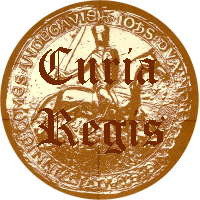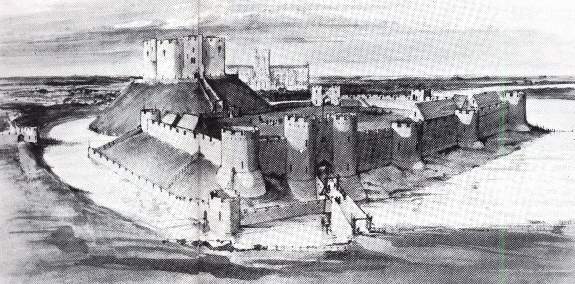
 |
Deputy Sheriff
Walter, the king is going to make me sheriff of Northumberland and Yorkshire. It is a big job even for one county. Doing two would be impossible without help. So the king said he would appoint two deputies for Yorkshire, and I would like you to be one of them [Morris, p. 155]
It was a big job. The sheriff was the king's man in the county. The sheriff was responsible for managing the king's land in the county. He also collected the taxes. He was the purchasing agent for the king. He organized the county court, and issued the king's proclamations there. He was responsible for arrest and jail, and thus was responsible for the prison. He assembled the knights when the king called for military service. And he was responsible for any ad hoc commission the king might give him [Morris, pp. 147-154]. He was almost all the government there was.
When William conquered England he appointed some of his most trusted lieutenants as sheriffs of the counties. They were also some of the richest men in the land. Sheriff became governing by the rich. That tradition continued with the appointment of William de Stuteville in 1200 [Clay, pp.5-13]. His family first received their land from William Rufus in the 1090s, and he held property in at least three counties. His father, Robert, and he had worked closely with Henry II. When John became king he regularly called on William for assistance until William's death in 1203. Walter de Boynton was not rich, of course. But he was known widely in Yorkshire as a judicious person and a good person to work with -- a good reputation for a deputy sheriff.
Walter, I particularly want you to take responsibility for the king's castle in York. You know the history and how politically sensitive that is going to be. Walter did know the history [Dobson, 1974].
It had happened ten years earlier, in 1190. Richard had just become king. His chancellor, William Longchamp, had gotten his brother Robert Longchamp appointed Abbot of St. Mary's Abbey, York, where Walter was chief financial officer [Conway, pp. 15-42; Craster and Thornton, p. 2]. Then Richard and his chancellor left for Normandy. At that point things boiled over in York. His friend William Percy was involved along with many others [Dobson, p. 33]. They began to attack the Jews living in York; mobs killed some Jewish families and threatened the rest. The Jews fled to the king's castle. John Marshall, who was sheriff at the time, did not have a clue about what to do. He tried persuasion. He tried force. He tried turning the Jews out of the castle. He just made things worse [Dobson, p. 26]. The Jews defended themselves in the castle for two days, but then decided that suicide was preferable to the murder the mob outside was going to inflict on them. Many of the families in the castle killed themselves; a few left the castle and were murdered by the mob. In the melee the king's castle, which was still timber construction, was burned down. And Walter and the monks of St. Mary's Abbey just watched -- unable to stop the slaughter [Dobson, p. 32] It was the most serious massacre of Jews in the middle ages [Dobson, p. 18]. It was a low point in the history of York. It was horrible.
When Richard II heard about the massacre he exploded. The Jews had the special protection of the king in return for being a lucrative source of revenue; the king was a "silent partner" in their money lending [Herman, p. 48]. He was losing money as well as being challenged by the locals. He sent Longchamp back to England to settle things. Longchamp picked up his brother Henry, who was sheriff in another county, and a military company on the way to York. When they got to York John Marshall, the sheriff, was fired; he was replaced by Osbert, another brother of the chancellor. Suddenly there were Longchamps everywhere. The chancellor said -- who did this? No one raised his hand. So Longchamp said, you will all pay. He immediately arrested 100 of the most prominent citizens of York and tossed them into jail. They were all released, but only after being assessed fines ranging from 100 marks to a half-mark [Dobson, pp. 29, 32]. It then took several years and hundreds of pounds to rebuild the castle.
This history was fresh in the minds of everyone in York. The Jewish community had returned, and they were again the money lending center for the county. The king, now John, was taking a big cut. The local nobles were happy to take the loans but angry about having to pay them off. This is what Walter was walking into by becoming deputy sheriff in charge of the king's castle at York. Nevertheless, Walter agreed and he was appointed.
The king, etc, to G, son of Peter, etc. Know that we have entrusted to William de Stuteville the sheriffship of York, with York castle and Pickering castle together with the bailiwick; he himself has deputed Walter de Boynton in his place to receive the sheriffship of York together with the castle, John de Meausse to receive the castle of Pickering together with the bailiwick. And likewise, we enjoin you that you enjoin your sheriff and constable through letters and make clear that they are to vacate those places. And as proof of this we send you our letters. With myself as witness at Alnwick, on the 12th February (in the second year of our reign) [Clay, p. 113].
 |
The castle had been rebuilt as a timber, mote and bailey castle [Cooper, pp. 24-28]. The keep sat atop the mote/mound, and was protected by a moat. The bailey was below the mote and was also protected by a moat. It would be rebuilt as a stone castle by Henry III, but when Walter was in charge it was still a timber castle with a shape rather like the picture, which is a drawing of what the castle must have looked like. And Walter was in charge; pretty impressive for a self-made man who started life in village Boynton.
The Curia Regis Rolls contain two reports from deputy sheriff Walter de Boynton. One concerned a land transaction [Curia Regis translation]. William de Radeclive had been in prison -- for an unspecified time. Before going to prison he gave land to Nicholas de Quercu. De Radeclive claimed that he gave the land to de Quercu to hold until he was released from prison. Now that he was out of prison de Quercu should give it back. De Quercu claimed that he had been given the land when he married de Radeclive's daughter. But since de Radeclive wanted it back he agreed to return it. This appears to be conflict between a father and a son in law; that may be what it was. However, there was no office for registering land transactions, and the courts became one way to produce an official record. You have a friendly controversy that the court -- or deputy sheriff -- must resolve. Then the record of that resolution became an official record of the transaction. This case may have been either.
Walter: Groan! John what are you doing?
The John in question was John de Harpham. The Harphams lived just down the road from Boynton, and Walter had known them all his life. Robert Harpham had been the abbot at St. Mary's for a time while Walter was the chief financial officer. And Walter and John Harpham, both the father and the son, had worked together on several projects -- including assisting Alice de Stuteville with land transactions [Clay, pp. 133-134].
Walter: The king is an autocratic "expletive deleted." He will have your head -- and mine will not be far behind -- if you get cross purposes with Peitevinus. That is taking money out of the king's pocket.
The second report of deputy sheriff de Boynton concerned a controversy that was eerily reminiscent of the controversies a decade earlier. It was conflict between Jewish money lenders and gentry of the county. It was the same location -- the offices of the Archbishop of York. It had, in a more recent phrase, disaster written all over it.
There are three documents in the Curia Regis Rolls about this event. The first reads like a quick first report that Walter dashed off to send to the king. The second is a more fully developed and somewhat different statement of what happened. The third is the assignment of a court date for the arrested parties.
Herbert de Lutton owed Peitevinus and Isaac, son of Isaac, 90 pounds in two loans/bonds. John de Harpham wanted to buy the loans [we call it a secondary market] if Herbert de Lutton's son, Thomas, would also guarantee the loan. John de Harpham would pay Peitevinus 30 marks for the bonds in four payments. Peitevinus did not want to turn over the bonds to de Harpham until he had been paid, and he asked the witnesses to hold onto the bonds until the first payment.
At that point John de Harpham said to Walter -- they are acting illegally. Arrest them. And that is what he did. He arrested them and seized their property. Then the memory of a decade earlier took over. Everyone began trying to present what they are doing in the best possible light. Walter reported that he had been able to arrest the Jews and seize their property with the aid of "law-worthy knights" and "law-worthy citizens of York." The Jews called in James de Poterna, the abbot of York [probably the head of the Abbey where Walter was chief financial officer], and many others to witness that they have been arrested. They did not want to be secreted away to be treated harshly.
As is characteristic of judicial proceedings from the twelfth century, there is no report on what happened in court. We can assume that the king thought Walter had handled a potentially explosive situation judiciously because only a few years later he invited Walter to serve on his court when it visited York.
William de Stuteville was sheriff for two years: 1200 to 1202. It seems very likely that Walter de Boynton was his deputy for the two years. For Walter, it was the start of a decade of public service.
....
Clay, Charles Travis (1952) Early Yorkshire Charters, Vol. IX, The Stuteville Fee, Yorkshire Archaeological Society, Record Series, Extra Series vol. VII
Conway, Agnes Ethel (1923) The Family of William Longchamp, Bishop of Ely, Chancellor and Justiciar of England, 1190-1191, Archaeologia Cantiana: Being Transactions of the Kent Archaeological Society. The author seems to have the date of Robert Longchamp's appointment as abbot of St. Mary's incorrect. She gives the date as 1197, but the Craster and Thornton (1934) gives the date as 1189.
Cooper, Thomas P. (1911) The History of the Castle of York, Elliot Stock, London.
Craster, H. H. E. and M. E. Thornton, ed. (1934) The Chronicle of St. Mary's Abbey, York, from Bodley Ms. 39, Surtees Society, vol. 148.
Curia Regis Rolls of the Reigns of Richard I. and John, vol. 1, His Majesty's Stationery Office, 1922, p. 397.
Dobson, Richard B. (1974) The Jews of Medieval York and the Massacre of March 1190, Borthwick Papers 45, St. Anthony's Press.
Herman, Shael (1993) Medieval Usury and the Commericalization of Feudal Bonds, Duncker & Humblot.
Morris, William Alfred (1927) The Medieval English Sheriff to 1300, Manchester University Press.